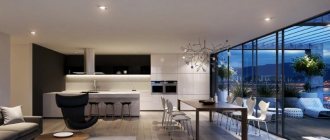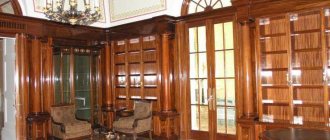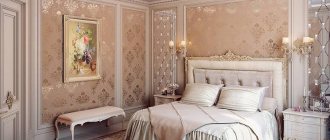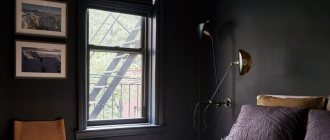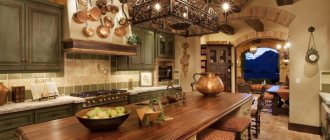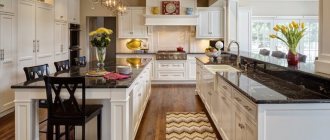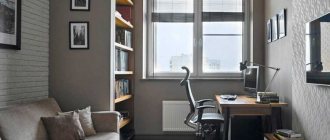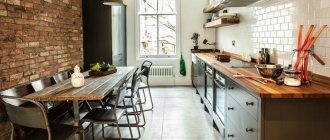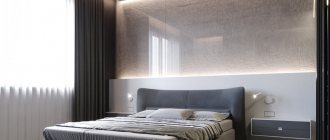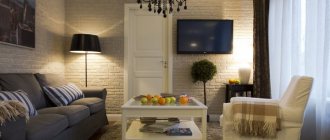A new apartment is a great event for any family, because there are so many interesting things ahead: choosing a design solution for the space, filling it with stylish furniture, searching for interesting decorative items, breathtaking discussions about the future decoration of the house. The latest trends in interior design demonstrate a move away from the minimalism that has been popularized in recent years, and a return to the creation of warm, comfortable interiors filled with the necessary style elements, colored with modernity.
Features and options of the European style
European style in the interior is a modern interpretation of traditional style options. The absence of strict requirements for the obligatory copying of finishing techniques of historical styles easily fits this trend into modern life, makes it in demand among customers, and allows designers to design cozy, elegant spaces filled with air and light. Conventionally, European style can be divided into classic and modern.
| Style Options | European classics | European modernity |
| Distinctive design elements | Large windows with glazing, the use of an arched finial with a fan-shaped frame Classic floor coverings (parquet, parquet boards) | Large window openings, single glass Use of floor tiles, porcelain tiles in living rooms |
| Features of finishing, accessories | Filling the room with side tables and coffee tables Curtains on a curtain rod hanging on both sides of the window Multi-shade chandeliers of complex design | Limiting the number of small furnishings Roman blinds or no curtains Single-shade volumetric luminaires |
One of the main characteristics of European-style apartment design is matte finish.
Dense, velvety finishing materials and fabrics are used. Muted shine is acceptable to a limited extent:
- metal fittings for doors and windows (latches, handles, hinges);
- curtain holders, cornices, plumb lines for Roman blinds;
- lighting fixture parts;
- accessories, decorative objects (vases, candlesticks, fireplace sets, picture framing).
Features of modern European style
The style is characterized by minimalism, demonstrating a move away from pomp, bombast, and bright and colorful furnishings. Thanks to simplicity, he refuses excess consumption and excesses in interior design.
Designers and decorators pay attention to the main features of Eurostyle:
- the use of high-quality environmentally friendly materials that are safe for the environment: wood, felt, natural fabrics, glass, porcelain stoneware, leather and fur scraps can be disposed of or recycled;
- absence of plastic as a working material;
- using a minimum amount of furniture and things that overload the free space;
- painting the walls instead of wallpapering them;
- denial of materialism as an addiction to expensive, rare items and antiques.
Europeans value the functionality of furnishings and decor, their appropriateness in a particular room.
Stylish color scheme: avoiding bright colors
In European classics, the use of a limited set of light colors is not a flaw, but an advantage. A huge number of shades of varying degrees of saturation create a rich palette of interior colors. Preference is given to pastel, whitewashed options, color accents are muted. Instead of pure, flashy colors, a more restrained range is used.
Against the background of light walls, upholstered furniture and fabric decor successfully sound old brick, matte chocolate, dark green, gray-blue, warm dark gray, and other complex color combinations.
When decorating an interior in a European style, avoid dark door panels and narrow baseboards that match the color of the floor. White reigns here. Doors and portals of any shade of white are preferred: creamy, snowy, bleached wood.
Creation of a European interior
To introduce European style into your apartment or house, you must fulfill its basic requirements:
- In no case should you overload the interior with furniture, especially with bulky cabinets. Let all the furniture be more of a decorative character. Ideally, one room should be set aside as a dressing room and all things should be stored there (for example, in Khrushchev-era apartment buildings you can turn an ordinary storage room into a dressing room). If you do not have the opportunity to equip such a room, try to choose compact wardrobes.
- Using armchairs and a sofa from one set in the interior is boring and banal. This design is long gone. Let the chairs be completely incompatible with the sofa in shape and color.
- Give preference to mobile and transformable pieces of furniture. With their help, you can easily change and refresh your interior.
- The European style is characterized by a combination of light doors and dark floors.
- Try to choose a light baseboard for the walls to match the light doors. Moreover, the plinth should be wide enough - about 10 cm. This is not only a stylish solution, but also a very practical one.
- It is best to decorate the bathroom, room and toilet with small, light tiles. In this case, light does not necessarily mean only white. European style welcomes the use of mustard, brick, light green and other non-standard tones in the bathroom interior.
Related article: Floor vase as a decorative element
Interior decoration: simple at first glance
The standard finishing technique in European design is plastering the walls followed by painting.
Any defect during plastering work will become clearly visible after painting, especially when the electric light is turned on. Therefore, the quality of plastering should be checked very carefully. A construction lantern can come to the rescue: when the lighting angle changes, its beam will highlight all the imperfections.
Parquet, parquet boards, and laminate are used as floor finishing materials for the main space. In auxiliary rooms (bathroom, laundry room, pantry), ceramic tiles, porcelain stoneware, and natural stone that are more suitable in terms of characteristics are used.
Decorating the walls of rooms with high humidity involves the use of tiles, painting with moisture-resistant paints, or a combination of these materials (places with splashes of water near the bathroom, washbasin, shower compartment walls are tiled, the rest of the space is painted).
European-style furniture: the main criterion is convenience
When creating a European interior, it is necessary to combine different pieces of furniture, since the use of full-fledged sets is not encouraged. But careful selection of furniture can create the effect of a lived-in, cozy space.
A distinctive feature of the furniture filling the house is convenience. This is the most important criterion followed when choosing. Sofas, tables, chairs should not only decorate the room, fit into the designed color scheme, but also create an atmosphere of complete comfort. That’s why it’s so important not to just stop at the picture you like in the catalogue, but to physically test how comfortable it is to sit on chairs, whether it’s easy to get up from a low sofa, whether your body feels relaxed on the couch.
An almost obligatory accent is the presence of chairs on legs in the rooms. These can be either options with high quilted backs, curved armrests, or more modern, linear or rounded shapes.
Thoughtful lighting: we include different scenarios
The use of several groups of lamps allows you to demonstrate in the European style the entire necessary light range: daytime, evening, ceremonial, work lighting. Sometimes linear lighting is designed behind the ceiling cornices, but much more often light points are used:
- top chandelier;
- sconces that accent certain areas of the room;
- floor lamps for reading, creating the necessary lighting intensity near sofa groups or armchairs;
- table lamps with large lampshades.
Decorative lampshades of lighting fixtures are themselves elements of decoration. They create a soft, subdued light that echoes the glow of a live fire in the fireplace, making the atmosphere of the room more comfortable. Fireplace lighting in the evening, when all other light sources are extinguished, gives a fluctuating glow of reddish shades, adding mystery to the interior. At this moment, the reflection of the flames from the metal accessories of the room becomes especially interesting. The placement of a fireplace in the bedroom is extremely effective; thanks to the warmth and soft light, the private space turns into even more private.
Interior accessories and architectural details
European-style decor includes:
- paintings (possibly single or symmetrical arrangement of objects);
- lamps, floor lamps with volumetric shades;
- floor and table vases with fresh flowers, indoor plants or wood installations;
- decorative pillows (a comfortable component of armchairs and sofa groups).
In the project, special attention should be paid to the following points:
- Door dimensions: it is desirable to manufacture custom-made elongated doors or double swing doors;
- High plinths with profiling: the size range fits into the range of 10-25 cm, tied to the overall height of the room (the higher the ceiling is raised, the wider the plinth is selected);
- Elongated window openings: often framed with figured platbands, which presents the landscape outside the window as a picture in a frame;
- The length of the curtains: soft folds (the fabric even lies on the floor) additionally emphasize the height of the room.
The classic European style uses ceiling cornices that echo the baseboards. The modern direction allows the junction of the ceiling and walls without additional design, the main thing is that it is executed perfectly.
Where to use this design
A design of this type will suit almost any corner of the house. However, each of them will be designed taking into account the characteristics of this particular room or premises:
- General simplicity reigns in the kitchen, although the furnishings are more technological than in the other rooms.
- The living room is a more traditional place and modern technical innovations will not feel comfortable here. A traditional fireplace or a beautiful large sofa with pillows would fit better into the decor of this room.
- If the European style is used in the bedroom interior, then you can deviate a little from the general rules for the sake of your own comfort - hang thick curtains and the furniture may not be so rectilinear and angular.
Any other premises and rooms are decorated based on their purpose and require only adherence to the general concept - a certain color scheme, the minimum possible load of furniture and the creation of the most comfortable environment. The rest is up to your taste.
European living room: warm classic, created for communication
The living room, as the main room in the house, more than other rooms meets the principles of European style design. It is not painted with age-appropriate details like a child’s room, it does not carry notes of intimacy like a bedroom, and it should not be practical to clean like a bathroom. But it is in this room that the purity of style is manifested: decoration, furniture, and accessories are selected very precisely. The result is a bright, open space that offers the occupants of the home maximum comfort.
In the center of the living room there is a coffee table, which is surrounded on three sides by sofa groups, armchairs, and side ottomans. The fourth side is given to the dominant vertical element: a fireplace, television equipment, a collection of paintings, i.e. visual accent of the entire composition. Upholstered furniture stands freely relative to walls and windows, providing a person with unhindered movement. The arrangement of the seats is often diagonal.
Room decoration
Living room, hall
The European-style living room is a bright, comfortable room with a coffee table in the center. It is surrounded by a sofa group, armchairs (often located diagonally) and poufs. It is convenient to admire the fireplace, paintings, and watch films here.
Upholstered furniture is moved away from walls and windows, providing free access to every corner. The whole family gathers here, so soft chairs and sofas, blankets and carpet create comfort.
Bedroom design
The bedroom creates an atmosphere for rest and relaxation: calm colors, parquet flooring, soft felt upholstery of bedroom furniture. In the center there is usually a natural handmade carpet. Beautiful furniture made of solid wood, silk lampshades emitting dim light.
More: Interior decoration in neoclassical style
Decorative elements are used within reasonable limits. Vases, photographs and paintings, mirrors should not be placed in excess.
Kitchen
An extensive European-style kitchen or its variants, including a dining room or living room, occupy a considerable area. The interior is zoned, dividing the area visually. A small kitchen area requires a more laconic design.
European style kitchens include:
- dining group with half-chairs instead of chairs;
- a set of kitchen furniture with paneled or solid doors;
- Roman blinds to match the print of furniture textiles;
- chandelier located directly above the table.
A bathroom is not just a room of a few square meters with basic decor. It helps you relax and relieve tension. Her whole environment contributes to this. The ceiling is decorated with a chandelier, next to the mirrors there are sconces of a similar format, and the light-colored floor visually increases the area.
The surface of the walls is tiled, alternating with painting, and the color scheme of the two types of decor is different.
Children's
The room for children is made brighter than others, and the objects in it are comfortable and safe. Materials for decoration are chosen lighter, brighter curtains, wide baseboards, and chests of drawers with legs.
Little ones will love the low and wide window sills: they won’t have to climb onto a chair to sit and draw at the table.
Teenage boys and girls will feel good if everything is done in a “grown-up” way. The interior should include a mirror in a baguette frame, a table, cabinets under glass and a solid chair.
In the European style, a new trend is coming into fashion - aroma design, the essence of which is the presence in the house of a scent selected by professionals.
The wow effect in houses decorated using European style is achieved through complete harmony in the interior.
Elegant bedroom for complete relaxation
European style is great for creating a relaxed, relaxing space, which is the bedroom. All design techniques are appropriate here:
- calm colors;
- parquet flooring;
- voluminous quilted upholstery of the headboard, armchairs, bedside bench, toilet ottoman;
- a handmade rug highlighting the center of the room;
- furniture made of wood of noble shapes;
- silk lampshades giving a subdued romantic light.
Inside the bedroom, nothing should interfere with proper rest, so decorative accents (mirrors, vases, framed photographs) are used in doses.
European studio apartment design: some tips for choosing a style
In recent years, small-area, open-plan housing has become popular. The design of a small studio apartment has aroused the interest of residents of our country in the traditions of multinational Europe, where effective techniques for rationally furnishing premises have been developed. In addition, new residents are attracted by a large selection of inexpensive European products. Their thoughtful shape and aesthetic appearance allow you to create the appearance of your apartment according to your needs and taste.
The European style interior layout is elegant and simple. There is nothing random or useless in the setting: every item has a practical purpose and creates the necessary comfort. The style is usually called minimalistic.
Compact sliding structures are considered elements of European design, although the idea of movable partitions came from Japan several centuries ago. But sliding wardrobes, doors on rollers and mobile screens have become part of the everyday life of studio apartment owners.
Modern designers continue to work on the designs and appearance of lightweight portable partitions. Screens allow you to change the appearance of your apartment in a matter of minutes.
A rational layout of a small area is not complete without spacious wardrobes built into the free walls of the room. They are installed in the hallway, living room and bedroom areas, and children's corner.
The wardrobe can be multifunctional - equipped with a hanger, a niche for equipment or a work desk.
A typical representative of the minimalist design trend is the Scandinavian style. Decorative artists from Sweden and Finland have created interesting options for functional but beautiful interiors that combine objects made of plastic and natural materials.
The apartments are furnished with everything necessary, but look spacious and “weightless”.
A characteristic feature of Scandinavian design is the discreet colors of the finish. Bright accents can be lamps of unusual shape, harmoniously combined with interior elements.
Supporters of more refined furnishings can opt for the French style of design. This direction is distinguished by the use of environmentally friendly materials and careful selection of design details. Wooden fronts of drawers, cabinets and door panels are usually coated with white paint.
Soft pastel colors of finishing materials make the room cozy and cheerful.
In contrast to the cheerful French, English design assumes in the interior high-quality classic furniture made of high-quality natural wood, and the color scheme of the finish is darker and more saturated. Decoration with antique items is welcome: clocks, lamps, chests, ancient engravings.
To make the room look visually more spacious, you can use a combination of shades of beige. And make expensive antique objects not only decorations, but also useful devices.
A characteristic feature of an English-style room is the presence of a traditional or bio-fireplace. To simulate a live fire, an electric model or a false panel decorated with candles is also suitable. The main rule: the hearth must be stationary, and its design must be combined with the interior design.
When planning the design of a small apartment, note that the decor can be not only ascetic, but also elegant. If you have sufficient financial resources, use the time-tested ideas of designers. When creating your interior project, it is not necessary to follow all the rules and canons of the chosen style - you can give free rein to your imagination and experiment.
Elements of classics in the kitchen space: cooking and eating in a European way
European style implies a large kitchen space. It could be
- separate spacious kitchen;
- combined kitchen-dining room;
- kitchen combined with living room.
The latter option will allow you to create a European-style interior in a studio or one-room apartment, where the walls between different rooms have been demolished.
If the kitchen area is very small (appendix), but adjacent to a voluminous dining room, then you can abandon the design of the kitchen in the general context, using a more laconic design. It will be possible to do justice to the chosen interior direction by creating the image of a place for family meals.
European style of cuisine is emphasized by:
- dining group, where half-chairs are used instead of hard chairs;
- kitchen set in discreet colors with paneled or flat facades;
- Roman blinds, matched to the tone of the furniture upholstery;
- a full chandelier placed above the dining table.
European style furniture
European-style home furnishings do not tolerate compliance with conservative rules. It is much better if representatives of different headsets meet in the same room. Although they differ in color and shape, they have minor common characteristics.
In order to preserve as much free space in the room as possible, it is advisable to give preference to multifunctional furniture.
Furniture in European interiors traditionally has smooth and even surfaces, and its finishing corresponds to the spirit of minimalism. Depending on the emphasis of the interior design, modern or vintage furniture is selected.
Vintage European style implies the presence of carved cabinets and shelves, round coffee tables and stools with curly legs. The geometry of furniture in a modern European style is characterized by simplicity and restraint.
Upholstered furniture should be light, high quality, low, attractive and comfortable.
In the interior of a European kitchen there is often a massive wooden table located strictly in the center of the room.
A bathroom you don't want to leave
A European-style bathroom is not a utilitarian room with a limited amount of decor, the finishing of which requires a minimum of funds. This is a corner of relaxation full of soft warmth. A voluminous bathroom allows you to plan the placement of an ensemble of a ceiling chandelier and matching sconces near the mirror, and a light floor covering expands the boundaries of the room. Wall decoration is possible according to the “top-bottom” principle - a combination of laying wall tiles and painting. Against such a background, plumbing fixtures with discreet, streamlined configurations look more advantageous. The junction of different finishing wall materials is decorated with a figured tiled frieze. An interesting technique is to paint vertical surfaces with a color different from the main tone of the tiles, which makes the bathroom less conservative.
Children's room: combining age and style
The difficulty of designing a space for small family members in a European style is that the age characteristics of children mean a bright room for games, and the chosen design means calm and comfort. Therefore, it is better to use only individual style elements:
- Calm colors of finishing materials;
- The flooring is lighter than the floor of the main home space;
- Wide baseboards;
- A combination of traditional and Roman blinds in brighter shades;
- Dressers with legs.
If the children's room is intended for teenagers, then furnishings “like those of adults” (a mirror in a baguette frame, a desk, glazed shelving, an armchair with a quilted back) will make a busy life measured and help balance the outburst of energy.
European style in the living room interior
Simple practical recommendations will help you decorate your living room in a true European style.
- To decorate the ceiling, choose stretch fabrics, lay parquet boards on the floor, and the walls can be partially painted and partially covered with wallpaper. Combining different types of wallpaper in one room is also trending. The main requirement is that they must be in harmony with each other and not tend to the foreground.
- Lovers and connoisseurs of natural beauty can not restrain themselves and decorate the walls with panels made of bamboo, cork or other natural material. This is quite in a modern European style. You can pay tribute to stone textures and decorate one wall with decorative tiles or artificial stone. A fireplace niche will look especially good in this design.
- You can choose a calm color scheme, with a light, peaceful background, and a few bright accents. Gone is the trend of choosing neon, overly bright colors for emphasis. Nowadays only natural colors are used. Chocolate and green can be a good choice for a cozy living room, while floral and floral ornaments and accessories are suitable for a bright and dynamic living room.
- The floor can be decorated with a carpet; dense, high-pile products are popular, or, on the contrary, even, smooth, similar to thick knitted fabrics.
- The windows in such a living room also need to be decorated, although this is neglected in many European interiors. The best option would be practical roller blinds. They will do their job especially well if you decide to include a window sill in the general space of the room and organize, for example, a resting place on it. Fans of classic solutions can choose curtains with eyelets made of thick material. They look great, and at the same time, are highly practical and functional.
- You can choose storage locations either open, in the spirit of Scandinavian interiors, or completely closed, built into the plane of the wall.
- Furniture for a living room in a European style will need smooth shapes, without excessive decorations. It can be asymmetrical, with an intricate outline or with unusual legs. However, the requirements for smoothness, minimalist finishing and high functionality remain relevant.
Old story in a new reading
Having given preference to European design, after the renovation the apartment owner will not have the use of mossy classics, but a fresh look at traditional things. A voluminous, bright room conducive to relaxation can become a magnet, thanks to which all family members strive to get home as soon as possible after a working day. An apartment, decorated in the chosen style, is ready to hospitably open its doors to welcome visitors and envelop those who live inside its walls in a cloud of calm comfort.
